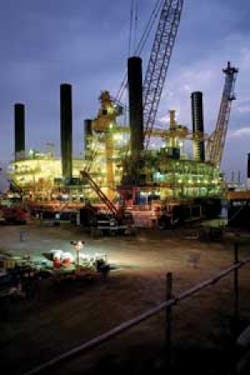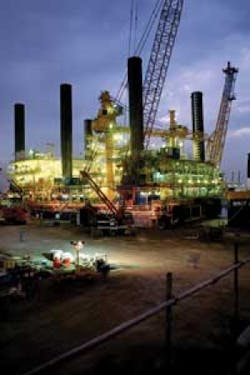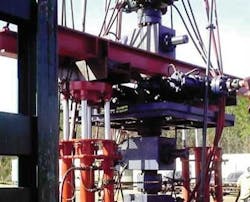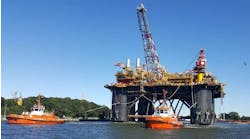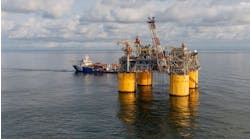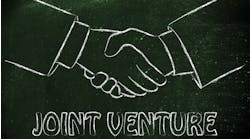Drillers address changing technology, manpower, security needs
Jeremy Beckman
Editor, Europe
Finding a competitive edge and retaining it in hostile environments were among the topics under discussion at this year’s SPE/IADC conference in Amsterdam.
Day 1 plenary session panelists outlined their thinking on Sustainable Competitive Advantage in an Era of Fast Followers. Claus Hemmingsen, CEO of Maersk Drilling, said a constant flow of investment in manpower and new technologies was the accepted formula for frontrunners in the drilling sector.
“However, we believe that being innovative also provides a sustainable competitive advantage. In terms of the drilling industry, we see this as offering an integrated services solution which is attractive to the contractor and the client.”
And once this edge is established, he added, it must be either sustained or renewed periodically.
Maersk’s approach, Hemmingsen explained, has been “to invest in a young, technologically advanced drilling fleet, but we also need the right balance of people, equipment, and processes.”
Tutorial training programs are critical in this regard. Maersk has designed sessions involving five to six weeks of classroom training specifically for its newbuild rigs. And the company is building a 3D simulator to create wide-ranging scenarios for all its rigs, with crews training together as teams rather than as individuals (as before) preparing for a certificate.
“But it’s also important to operate a highly advanced management system to follow up the performance of our entire fleet. Macondo highlighted weaknesses in the industry’s management systems – we need to enable our crews to take the right decisions in the right way. One thing that creates a competitive advantage in rig operations is consistency.”
John Bannerman, Total’s VP Drilling Completion, said that for an operator, sustaining a competitive advantage meant “somehow keeping all our ‘clients’ happy, i.e. our geoscientists, reservoir engineers, partners, and local authorities”, while at the same time working in increasingly difficult environments such as deepwater, HP/HT, or with managed pressure drilling.
“Also, the key is to pick the right technology at the right time…what you do in Lagos or Luanda may not be the same as what you do in Houston and Aberdeen. Locational requirements make it more difficult to apply certain technologies in parts of the world.”
Another concern for operators, Bannerman suggested, was keeping abreast of new technology developments.
“There’s a lot of literature, but not always the time to read it. For everyone in a company to know what’s going on within their sphere is a major challenge. You need to manage you own knowledge, but you also need to identify ‘technology gaps’ – areas where [enabling] technology does not yet exist.”
Pete Miller, chairman, president, and CEO of National Oilwell Varco, said that the industry must maintain its drive to make drilling technology safer above and below ground. Increasing automation has helped, he claimed – “taking more staff out of harm’s way makes it safer. But to do this, you have to raise the bar…Take continuous circulation systems: the way for us to go is to make these systems less complex, and to operate more reliably in the well. But sometimes in this industry we introduce complexity without improving reliability. It doesn’t help anyone if the system can’t run right or reliably.”
Another goal, Miller suggested, should be improved data management.
“He who controls the information will win the game. But first you have to get that information from downhole and confirm its veracity. The sustainable advantage then comes from interpreting and using it as quickly as possible to help achieve continuous improvements.”
The environment, Miller said, was another issue driving the industry’s development. This is evidenced in the new rigs suited for arctic operations, and the huge investments in R&D for equipment to suit all types of environments. However, the industry also needs to ensure staff is trained appropriately, he added, and that requires investment.
“You can’t afford not to train: today, the biggest sustainable advantage is having people who know what they’re doing when they go out and work on that equipment. Everyone needs academies to train their people – the results may not be manifest today, but they will five years from now.”
Satish Pai, VP Operations for Schlumberger Oilfield Services, said his company consistently invests over $1 billion/yr in R&D.
“Even in a downturn we do not cut our R&D budgets…companies that have that capability will come out on top, because technology is a long-term gain.”
Another frustration for Schlumberger, Pai said, was the difficulty in getting cooperation with operators concerning the market’s future technology needs. And some of the developments that do ensue can be delayed by protracted disputes over who owns the intellectual property rights.
During the Day 2 plenary on “The Challenges of New Frontiers”, Mike Dyson, BG Group’s Well Engineering manager, recounted some of his company’s experiences as a relative newcomer to exploration offshore China and Tanzania. In the latter case, the company is about to assume operatorship of two exploration blocks from partner Ophir Energy.
“Going into new E&P countries,” Dyson said, “involves building relationships and developing influence via a network of contacts. Ophir had very good connections in Tanzania, and these worked very effectively for the partnership.”
But there are other hurdles to surmount in emerging regions, he added, notably logistics. In the case of BG’s recent wells off southern Tanzania, this meant upgrading the nearby port of Mtwara (previously used for exporting cashew nuts) to serve as a supply base.
“However, we knew that other oil companies in the area would also want to use this, so it was an investment for the future.”
Other challenges Dyson cited included trying to inculcate safety values in BG’s Chinese operations, and dealing with piracy off Tanzania’s shores, which meant bringing in the Tanzanian military to mitigate the risk.
“Hiring and developing local staff is also important, as is building an integrated collaborative environment with other operators – in faraway countries, sharing talent and information is useful when you don’t know too much about the place, or until you know the scale of your commitments.”
In terms of frontier drilling, BG Group is engaged in HP/HT and ultra-deepwater wells.
“It’s essential that we maximize the learnings from Macondo, and with an open mind,” Dyson suggested. “There is clearly increased scrutiny, not just from the public, but also from our board members, who want to know how we are organizing our activities.”
Other issues the industry should address, he felt, include management of change.
“We need to do better in terms of last-minute changes to well design, and how these are communicated. There are a large number of consultants on our rigs, and we need to make sure that our staff is competent. And we need to do better in encouraging people to raise their concerns – that means going in with an open mind and asking them ‘what’s concerning you, let’s hear about it’. Anyone in our contractors’ association who is concerned at the way we’re working can raise it with us at the highest level.”
Johan Surewaard, VP Wells, New Ventures for Shell International Exploration & Production in the MENA and Caspian regions, said his company had restored its personnel to Egypt after only recently pulling them out. Engineers need to get used to this type of situation, he suggested. As for frontier technologies, Surewaard cautioned against establishing performance drivers in the case of HP/HT and deepwater drilling.
“We must be careful not to push our teams to far to be the best, particularly when there is not too much known about the subsurface.”
Kevin Robert, senior VP Marketing & Business Development at Pride International, said there was increasing demand from operators for modern, multi-function MODUs providing a full range of services, including completions and testing activities. One dilemma for the industry, he suggested, was how to accelerate the training program for staff operating the new technology on these advanced rigs. “The frontier is providing the competency…when it’s not there.”
The training shortfall is made more complicated by local content stipulations, he said.
“In Brazil, when a rig comes in to the sector, the requirement is for 20% of the crew to be Brazilian nationals within six months, rising to 66% within three years. The government’s objective is to eventually have 90 rigs operating off Brazil, even though the people are not there. But we still have to meet the local content target.”
Robert pursued this theme further. A new ultra-deepwater drillship, he pointed out, can involve two years of crew training. Then the situation can arise that the rig can’t secure a permit, so it has to move, say, to Brazil, which means losing or changing out highly skilled people. “In Angola, there is a great training base, but it takes one and a half years to get the crew ready, and [with that length of time] you risk losing a rig contract.”
Peter Fontana, COO of Weatherford International, spoke of the growing security issues in frontier regions.
“We need to find people prepared to work six months in a compound, or to go into areas where there is no back-up [for their skills]. One of the big challenges for service companies is to make what these people are facing safer, even more enjoyable, because many younger people don’t want to do this.”
Rotary steerable system widens drilling options
Technologies showcased at the SPE/IADC exhibition included PowerDrive Archer, Schlumberger’s new rotary steerable system (RSS). It is designed to drill complex 3D wells and openhole side tracks from any inclination, including vertical and horizontal sections in one run, without requiring a trip out of the hole. The system’s high build rate also allows it to kick off deeper and land early in the reservoir, while the directional control is designed to land the wellbore in the optimum location, however deep, and, if necessary, extend a horizontal section to total depth.
During field trials, the company says the system has consistently achieved high build rates in many formations, in some cases achieving 17º/100 ft. Most tests to date have been in the Middle East or onshore North America, with the system saving one Marcellus shale operator 10 days drilling time per well. PowerDrive Archer has featured in at least one well offshore Qatar, where the application involved reducing the well profile by keeping it vertical.
Schlumberger’s PowerDrive Archer RSS drilled this well from a vertical trajectory, building a 3D curve with more than a 100º change in azimuth.
Schlumberger says the precision steering needed for the high build rates is managed by a control system in the PowerDrive X6 RSS, which enables drilling with higher mud weights and a wider flow range. A closed loop inclination hold mode ensures a high level of accuracy at any speed.
The steering system incorporates internal pads that push against an articulated sleeve pivoted on a universal joint to point the bit where required. The reduced dependence on wellbore contact also facilitates openhole side tracking at any point in the well. All external parts on the RSS rotate, the effect being to improve hole cleaning and to cut the risk of stuck pipe.
Schlumberger also says that all wellbores drilled are smooth and consistent, leading to reduced torque and drag, and good weight transfer to the bit to maximize ROP, which in turn extends the distance that horizontal sections can be drilled.
XDT introduced the TAZ multiple activation circulating sub. More complex wells often require pumping of large volumes of drilling fluid or lost circulation material at some point, necessitating running of a circulation sub in the BHA.
These tools have offered a limited number of activations downhole, but that is not the case with the TAZ, XDT claims, which remains dormant in the BHA assembly area until opened by pumping down a “magic ball”. The resultant pressure drop allows the mechanism to engage, opening three ports to the annulus.
The “magic ball” is made from a naturally degradable material that vanishes on activation, ensuring a 2-in. clearance through the tool at all times. An identical ball is employed to close the ports – this too “disappears” on activation, leaving the tool dormant and ready for re-deployment.
Offshore Articles Archives
View Oil and Gas Articles on PennEnergy.com
